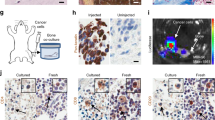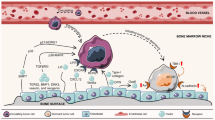Abstract
Breast cancer can reoccur, often as bone metastasis, many years if not decades after the primary tumor has been treated. The factors that stimulate dormant metastases to grow are not known, but bone metastases are often associated with skeletal trauma. We used a dormancy model of MDA-MB-231BRMS1, a metastasis-suppressed human breast cancer cell line, co-cultured with MC3T3-E1 osteoblasts in a long term, three dimensional culture system to test the hypothesis that bone remodeling cytokines could stimulate dormant cells to grow. The cancer cells attached to the matrix produced by MC3T3-E1 osteoblasts but grew slowly or not at all until the addition of bone remodeling cytokines, TNFα and IL-β. Stimulation of cell proliferation by these cytokines was suppressed with indomethacin, an inhibitor of cyclooxygenase and of prostaglandin production, or a prostaglandin E2 (PGE2) receptor antagonist. Addition of PGE2 directly to the cultures also stimulated cell proliferation. MCF-7, non-metastatic breast cancer cells, remained dormant when co-cultured with normal human osteoblast and fibroblast growth factor. Similar to the MDA-MB-231BRMS1 cells, MCF-7 proliferation increased in response to TNFα and IL-β. These findings suggest that changes in the bone microenvironment due to inflammatory cytokines associated with bone repair or excess turnover may trigger the occurrence of latent bone metastasis.





Similar content being viewed by others
References
DeSantis C et al (2013) Breast cancer statistics, 2013. Cancer J Clin 64(1):52–62
Klein CA (2011) Framework models of tumor dormancy from patient-derived observations. Curr Opin Genet Dev 21(1):42–49
Demicheli R et al (2007) Tumor dormancy and surgery-driven interruption of dormancy in breast cancer: learning from failures. Nat Clin Pract Oncol 4(12):699–710
Lipton A et al (2009) The science and practice of bone health in oncology: managing bone loss and metastasis in patients with solid tumors. J Natl Compr Cancer Netw 7(Suppl 7):S1–S29 quiz S30
Rubens RD (2000) Bone metastases–incidence and complications. In: Rubens RD, Mundy GR (eds) Cancer and the skeleton. Martin Dunitz, London 286
Naumov GN, Folkman J, Straume O (2009) Tumor dormancy due to failure of angiogenesis: role of the microenvironment. Clin Exp Metastasis 26(1):51–60
Demicheli R et al (2008) Recurrence dynamics does not depend on the recurrence site. Breast Cancer Res 10(5):R83
Aguirre-Ghiso JA, Bragado P, Sosa MS (2013) Metastasis awakening: targeting dormant cancer. Nat Med 19(3):276–277
Weiss L (1990) Metastatic inefficiency. Adv Cancer Res 54:159–211
Pantel K et al (1993) Differential expression of proliferation-associated molecules in individual micrometastatic carcinoma cells. J Natl Cancer Inst 85(17):1419–1424
Hedley BD, Chambers AF (2009) Tumor dormancy and metastasis. Adv Cancer Res 102:67–101
Takeuchi H, Muto Y, Tashiro H (2009) Clinicopathological characteristics of recurrence more than 10 years after surgery in patients with breast carcinoma. Anticancer Res 29(8):3445–3448
Pantel K et al (2003) Detection and clinical implications of early systemic tumor cell dissemination in breast cancer. Clin Cancer Res 9(17):6326–6334
Pantel K, Brakenhoff RH, Brandt B (2008) Detection, clinical relevance and specific biological properties of disseminating tumour cells. Nat Rev Cancer 8(5):329–340
Baccelli I et al (2013) Identification of a population of blood circulating tumor cells from breast cancer patients that initiates metastasis in a xenograft assay. Nat Biotechnol 31(6):539–544
Das Roy L et al (2009) Breast-cancer-associated metastasis is significantly increased in a model of autoimmune arthritis. Breast Cancer Res 11(4):R56
Yano S (2014) Metastatic bone lesion due to methotrexate and etanercept 24 years after breast cancer treatment. BMJ Case Rep. doi:10.1136/bcr-2013-202615
Rotolo N et al (2013) Metastasis at a tracheostomy site as the presenting sign of late recurrent breast cancer. Head Neck 35(11):E359–E362
Demicheli R et al (2008) The effects of surgery on tumor growth: a century of investigations. Ann Oncol 19(11):1821–1828
Schneider A et al (2005) Bone turnover mediates preferential localization of prostate cancer in the skeleton. Endocrinology 146(4):1727–1736
Tashjian AH Jr, Gagel RF (2006) Teriparatide [human PTH(1-34)]: 2.5 years of experience on the use and safety of the drug for the treatment of osteoporosis. J Bone Miner Res 21(3):354–365
Mundy GR et al (2008) Cytokines and bone remodeling. In: Marus R et al (eds) Osteoporosis. Editors Academic Press, New York, pp 491–528
Dhurjati R et al (2006) Extended-term culture of bone cells in a compartmentalized bioreactor. Tissue Eng 12(11):3045–3054
Cailleau R, Olive M, Cruciger QV (1978) Long-term human breast carcinoma cell lines of metastatic origin: preliminary characterization. In Vitro 14:911–915
Mastro AM, Vogler EA (2009) A three-dimensional osteogenic tissue model for the study of metastatic tumor cell interactions with bone. Cancer Res 69(10):4097
Phillips KK et al (1996) Suppression of MDA-MB-435 breast carcinoma cell metastasis following the introduction of human chromosome 11. Cancer Res 56(6):1222–1227
Krishnan V et al (2011) Dynamic interaction between breast cancer cells and osteoblastic tissue: comparison of two- and three-dimensional cultures. J Cell Physiol 226(8):2150–2158
Phadke PA et al (2008) BRMS1 suppresses breast cancer experimental metastasis to multiple organs by inhibiting several steps of the metastatic process. Am J Pathol 172(3):809–817
Sosnoski DM et al (2012) Changes in cytokines of the bone microenvironment during breast cancer metastasis. Int J Breast Cancer 2012:160265
Wang H et al (1997) Basic fibroblast growth factor causes growth arrest in MCF-7 human breast cancer cells while inducing both mitogenic and inhibitory G1 events. Cancer Res 57(9):1750–1757
Sato K et al (1986) Stimulation of prostaglandin E2 and bone resorption by recombinant human interleukin 1 alpha in fetal mouse bones. Biochem Biophys Res Commun 138(2):618–624
Sato K et al (1987) Tumor necrosis factor type alpha (cachectin) stimulates mouse osteoblast-like cells (MC3T3-E1) to produce macrophage-colony stimulating activity and prostaglandin E2. Biochem Biophys Res Commun 145(1):323–329
Bai X et al (2013) Prostaglandin E(2) receptor EP1-mediated phosphorylation of focal adhesion kinase enhances cell adhesion and migration in hepatocellular carcinoma cells. Int J Oncol 42(5):1833–1841
Sudo H et al (1983) In vitro differentiation and calcification in a new clonal osteogenic cell line derived from newborn mouse calvaria. J Cell Biol 96(1):191–198
Schneider CA, Rasband WS, Eliceiri KW (2012) NIH Image to ImageJ: 25 years of image analysis. Nat Methods 9(7):671–675
Pilbeam CC, Harrison JR, Raisz LG (2002) Prostaglandins and bone metabolism. In: Bilezikian JP, Raisz LG, Rodan GA (eds) Principles of bone biology. Academic Press, New York
Mundy GR et al (2001) Cytokines and bone remodeling. In: Marcus RE, Feldman D, Kelsey J (eds) Osteoporosis. Academic Press, New York, pp 373–403
Mark KS, Trickler WJ, Miller DW (2001) Tumor necrosis factor-alpha induces cyclooxygenase-2 expression and prostaglandin release in brain microvessel endothelial cells. J Pharmacol Exp Ther 297(3):1051–1058
Ono M (2008) Molecular links between tumor angiogenesis and inflammation: inflammatory stimuli of macrophages and cancer cells as targets for therapeutic strategy. Cancer Sci 99(8):1501–1506
Oshima H, Oshima M (2012) The inflammatory network in the gastrointestinal tumor microenvironment: lessons from mouse models. J Gastroenterol 47(2):97–106
Najmi S et al (2005) Flavopiridol blocks integrin-mediated survival in dormant breast cancer cells. Clin Cancer Res 11(5):2038–2046
Phadke PA, Mercer RR, Harms JF, Jia Y, Kappes JC, Frost AR, Jewell JL, Bussard KM, Nelson S, Moore C, Gay CV, Mastro AM, Welch DR (2006) Kinetics of metastatic breast cancer cell trafficking in bone. Clin Cancer Res 12:1431–1440
Blackwell KA, Raisz LG, Pilbeam CC (2010) Prostaglandins in bone: bad cop, good cop? Trends Endocrinol Metab 21(5):294–301
Ristimaki A et al (2002) Prognostic significance of elevated cyclooxygenase-2 expression in breast cancer. Cancer Res 62(3):632–635
Singh B et al (2007) COX-2 involvement in breast cancer metastasis to bone. Oncogene 26(26):3789–3796
Schrey MP, Patel KV (1995) Prostaglandin E2 production and metabolism in human breast cancer cells and breast fibroblasts. Regulation by inflammatory mediators. Br J Cancer 72(6):1412–1419
Cicek M et al (2005) Breast cancer metastasis suppressor 1 inhibits gene expression by targeting nuclear factor-kappaB activity. Cancer Res 65(9):3586–3595
Klein DC, Raisz LG (1970) Prostaglandins: stimulation of bone resorption in tissue culture. Endocrinology 86(6):1436–1440
Planchon P et al (1995) Evidence for separate mechanisms of antiproliferative action of indomethacin and prostaglandin on MCF-7 breast cancer cells. Life Sci 57(12):1233–1240
Sosa MS, Bragado P, Aguirre-Ghiso JA (2014) Mechanisms of disseminated cancer cell dormancy: an awakening field. Nat Rev Cancer 14(9):611–622
Wilson A, Trumpp A (2006) Bone-marrow haematopoietic-stem-cell niches. Nat Rev Immunol 6:93–106
Shiozawa Y et al (2008) The bone marrow niche: habitat to hematopoietic and mesenchymal stem cells, and unwitting host to molecular parasites. Leukemia 22(5):941–950
Mirza AA et al (2014) MEKK2 regulates focal adhesion stability and motility in invasive breast cancer cells. Biochim Biophys Acta 1843(5):945–954
Khoon MCS (2015) Experimental models of bone metastasis: opportunities for the study of cancer dormancy. Adv Deliv Rev. doi:10.1016/j.addr.2015.02.007
Acknowledgments
This work was supported by a pilot grant from METAvivor and by the U.S. Army Medical and Materiel Command Breast Cancer Idea Program, Grant W81WH-1s2-1-0127. We thank Dr. K. Sandeep Prabhu for thoughtful discussion.
Conflict of interest
The authors declare that they have no conflict of interest.
Author information
Authors and Affiliations
Corresponding author
Rights and permissions
About this article
Cite this article
Sosnoski, D.M., Norgard, R.J., Grove, C.D. et al. Dormancy and growth of metastatic breast cancer cells in a bone-like microenvironment. Clin Exp Metastasis 32, 335–344 (2015). https://doi.org/10.1007/s10585-015-9710-9
Received:
Accepted:
Published:
Issue Date:
DOI: https://doi.org/10.1007/s10585-015-9710-9




